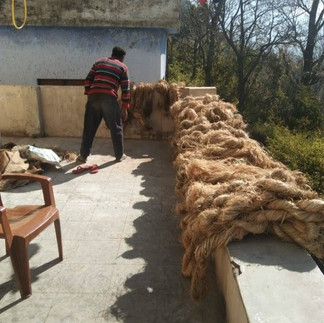The Story of the Himalayan Hemp Farmers
- Source For Future

- Jun 22, 2022
- 3 min read
Updated: Sep 21, 2022
Is it possible to bring mountain farming communities back from the brink of abandonment? Our partners certainly think so, in Uttarakhand, India they are on a mission to fight poverty in Himalayan farming communities. Following years of natural disasters and climate change-related farming hardships, many farmers have left their fields, often seeking labour in cities and towns instead. This is breaking up families, communities and traditional ways of life.
What if reviving centuries-old traditions could offer a solution for the farmers. A solution where they can continue living naturally in the beautiful Himalayan hills. By supporting the local, legal, cultivation and processing of hemp, Himalayan farmers can do what their forefathers did so well while, simultaneously, helping to bring the world closer to achieving sustainability.
Zero Plastic | Soft and comfortable | Durable | Reusable | Easy to clean | Anti-bacterial properties
Raw material
Hemp is a native plant in the Himalayan region, it was historically cultivated as a useful, easy-to-grow plant for various purposes, as well as a way to restore degraded farmland. However, following the legalization of cannabis spreading around the world in the 20th century, hemp was effectively criminalized due to its resemblance to marijuana. As a result, farming officially died out, leaving Himalayan farmers unable to reek the many social and environmental benefits of hemp cultivation.
The loss of hemp farmers led to the further degradation of the land and emigration away from the villages and traditional homelands. In 2017 hemp farming was legalized in India under a licensing scheme, but still is looked upon as controversial due to its associations with marijuana. Our hemp partners are working to support the small farming communities in getting back to their hemp roots. Hemp is a perfect solution to the challenges faced by Himalayan communities and can be an important contributor to reaching the UN Sustainable Development goals.
Hemp is one of the most sustainable crops there is and can be used for a variety of products. When comparing textiles hemp is much superior to cotton in environmental impact, and when harvested in rural areas hemp can have a high expected income for many independent farmers as the inputs for the hemp cultivation and the risk associated with the crop is small. In addition, hemp textile as a material offers many benefits you do not get with cotton, and certainly not with petroleum-based textiles such as polyester.
Production
The farmers are supported through the agricultural process of establishing a license, growing and harvesting the hemp. This includes training, delivery of legal seeds and continuous support.
After harvesting the hemp fibre is collected. The fibre is taken for either spinning and hand-looming or mechanical weaving. Following the spinning and weaving the hemp textile is tailored into products in small social tailoring units on the foothills of the Himalayas. These units provide further employment and growth opportunities, mainly to women, in the rural communities.
ENVIRONMENTAL IMPACT
By promoting the cultivation of hemp our producer contributes to combating the negative environmental impact of mass-produced cotton, reducing deforestation, and restoring barren and abandoned land.
UN Sustainable Development Goal

Utilizing traditional agricultural methods including the organic cultivation of hemp to improve soil stability and quality this producer is working towards target 13.1; "to improve community resilience and adaptation to climate change and natural disasters."
SOCIAL IMPACT
By working with the Himalayan communities in hemp farming and rural hemp textile tailoring the producer seeks to create a long term, sustainable community-wide growth and support initiative. This is done through providing training and by helping create cottage industries in the villages by adding value to the products and mobilizing community members with a special focus on empowering women in the process. By creating these opportunities it seeks to support reverse migration and enable entire families to thrive in their home villages while keeping to their traditions and culture.
UN Sustainable Development Goal

By supporting the sustainable development of small scale independent hemp farming practices and social tailoring units in rural Himalayan communities the project is contributing to target 8.2; "Achieve higher levels of economic productivity through diversification and innovation-with a focus on high-value-added and labour-intensive sectors."
#WomensEmpowerment #Organic #Vegan #RuralArtisan #IndigenousEmpowerment #IndependentFarmer #Handmade #NaturalLiving
.png)















Comments